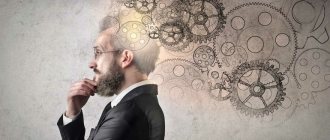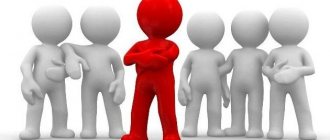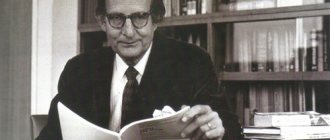Classification of activities
In social science, there is more than one classification of activity, but we will consider the most popular one - according to objects and results of activity.
Depending on what the result is - material wealth or cultural values - activity can be material (practical) and spiritual.
Material activity involves the creation of things and material values that are needed to satisfy human material needs. It is divided into material-production , associated with the transformation of the surrounding nature, and social-transformative , aimed at transforming society.
Products of spiritual activity - ideas, images, scientific, artistic and moral values. Spiritual activity is:
- cognitive - related to the reflection of the surrounding world in mythological, religious, scientific or artistic form;
- value-oriented - expressing a person’s attitude to the phenomena of the surrounding world;
- prognostic - involved in forecasting possible changes in reality.
Conscious human activity
Lecture on psychology Read more: Perception
2. Conscious human activity
The main distinctive features of human conscious activity: 1) They are always associated with biological motives. There are situations in which conscious activity comes into conflict with biological motives and suppresses them. The most common example is a person rushing to save others from a fire; 2) Human activity is not necessarily determined by visual impressions received from the environment or by traces of past experience. A person abstracts himself from them. A person begins to assimilate the universal human experience accumulated by previous generations.
3. Psychological characteristics of consciousness
The reflexive ability of consciousness, i.e. readiness to understand other mental phenomena and oneself. Without these abilities, a person would never be able to even imagine that he has a psyche. Thus, the psychological characteristic includes a person’s sense of himself, a cognizing subject. This means that a person realizes himself as a being separated from the world, ready and capable of studying and understanding this world. A person is aware of this knowledge, can formulate it, express it in words, concepts, transfer it to another person, store this knowledge, reproduce it, work with it as with a special object. When consciousness is lost, this ability is lost. The second characteristic of consciousness is the close relationship between consciousness and will. A person can imagine a real absence at a given moment or no existence at all at a given moment only arbitrarily. The third feature is the ability of consciousness to communicate, i.e. transmission to others of what a given person is aware of using language and other sign systems. By exchanging information with each other, people highlight the main thing in what is being communicated, this is how abstraction occurs, i.e. distraction from everything unimportant and concentration of consciousness on the most essential. Consciousness exists not only in verbal, but also in figurative form.
4. Emergence and development of consciousness
The main condition for the emergence and development of human consciousness is the joint, productive, instrumental activity of people mediated by speech. It requires communication and interaction between people. It involves the creation of a product that is understood by all participants in the activity as the goal of their cooperation. This goal must be defined and expressed in words. Before becoming the property of individual consciousness, a word and its content must acquire a general meaning for the people who use them. This happens for the first time in joint activity, having received universal meaning, the word penetrates into individual consciousness; at the beginning of its development, human consciousness is aimed at understanding the external world. A person realizes what is in him with the help of the sense organs given to him by nature. He sees, perceives, reflects this world as separate from it and essentially independent of it. This sequence of development of stages of consciousness is called reflexive.
5. Consciousness and unconsciousness
Along with consciousness, a person also has the unconscious. Unconsciousness is a form of mental attitude in which the image of reality and a person’s relationship to it do not act as a subject of special reflection. Freud introduced the concept of consciousness into science. He attributed to unconsciousness in a person those qualities, interests, needs in which a person is not aware of himself, but which are inherent to him and are manifested in a variety of involuntary reactions, actions and mental phenomena. Freud attributed erroneous actions to one of these phenomena - slips of the tongue, slips of the tongue, errors when writing and listening to words, involuntary forgetting of names, promises, intentions, objects, events, etc., which are directly or indirectly associated for a person with unpleasant experiences. The third group of phenomena of manifestation of unconsciousness are ideas associated with perception, memory and imagination.
Cognitive sphere of personality
1. Feelings
2. Perception
3. Memory
Thinking and speech, imagination. Attention: not mentioned in the lecture.
1. Feelings
Sensations are the simplest form of mental reflection, characteristic of both animals and humans and providing knowledge of the individual properties of objects and phenomena. Sensations are the source of our knowledge about the external world; they are the main channels through which information about the phenomena of the external world reaches the brain, giving a person the opportunity to navigate the environment. Methods for measuring sensations: direct and indirect. In psychology of the late 19th – early 20th centuries. There is an idea that the sensory organs (receptors) passively respond to influencing stimuli and, accordingly, sensations; from this point of view, sensations are a passive process. The reflex theory believes that sensation is an active process - the main position of this theory is as follows - every sensation includes movement. Complex sensations are not possible without active movement; an example of a complex sensation would be feeling an object with your eyes closed.
|
Creative activity
A special type of activity is creativity - the process of creating something qualitatively new, never existing before. Artists, writers, and scientists are engaged in creative activities.
Creativity can also be considered as a component of other activities. So, our applicant from the example above can be creative in the process of preparing a resume and come up with a completely new approach that will captivate the employer.
The key abilities for creative activity are:
- combine existing knowledge;
- create new images in the mind (imagination);
- create vivid, strong ideas (fantasy);
- gain knowledge unconsciously (intuition).
We will help you consolidate new material in social studies lessons at the Skysmart online school.
What is consciousness?
Consciousness is conscious responsibility for all areas of one’s life, both external and internal.
This is very easy to understand if you imagine the image of a conscious and unconscious person. What is the difference? A conscious person understands what he is doing and the consequences of his actions, while an unconscious person is not aware of either the consequences or what he is doing. For a conscious person, life is a structured and understandable flow. He understands his place in it and his path along which he has to go. Consciousness allows a person to perceive reality as it is. Without illusions, without rose-colored glasses and other factors that distort the real perception of the world. Consciousness allows a person to understand the boundaries of what is permitted and what is not permitted.
An irresponsible person shifts all responsibility onto others. For such a person, the blame for his problems and the problems of society lies with someone else: a neighbor, a friend, a wife, a ruler. Someone is to blame other than himself. However, there is an authoritative opinion that the person himself is to blame for the vast majority of his troubles. Of course, we nod our heads when we hear this; it’s hard to argue with anyone with even a modicum of intelligence. And yet, even understanding this principle does not guarantee us full consciousness.
Consciousness is acquired as a person matures, as his inner core grows and strengthens and he knows himself . Obviously, only a child transfers all responsibility to others, they say, it’s not him, it’s just that the whole world lives like this. Considering our society from the point of view of consciousness, we live in a society of children who are not responsible for their affairs, actions and lifestyle. If they succeed at something, they are great, and if it doesn’t work out, there is always someone to blame.










